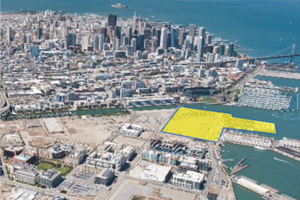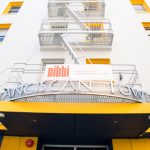Proposition D would make it possible for the Mission Rock waterfront development to move forward in the Mission Bay neighborhood.
Why is this on the ballot?
The 28-acre Mission Rock mixed-use development on the city’s southern waterfront would include housing and office buildings that could rise between three and six times taller — up to 240 feet higher for three towers — than the land’s current height limits allow. For the project to move forward, Proposition D must pass in accordance with a new law that voters approved in June 2014.
What would it do?
Proposition D would grant that official approval.
Is there a catch?
Proposition D would only give the project’s sponsor — the San Francisco Giants — permission to build to a proposed maximum height of 240 feet (23 stories) on Pier 48 and the west-adjacent land. Right now, new buildings on this land can be up to 40 feet tall.
If approved, the city would “encourage” that the project include 1,000 to 1,950 residential units, mostly rental, with at least 33 percent for low- and middle-income households.
The plan also calls for restaurants, retail, commercial, production, manufacturing, artist studio, small business and nonprofit spaces; 8 acres of parks, open spaces and recreational uses; rehabilitating Pier 48 to historic standards; and creating 3,100 parking spaces, most in an above-ground structure.
Even if this measure passed, aspects of the Mission Rock project might still change after the election. That is because both City Hall and the developer will be ironing out the final design over the next year or two. But some aspects of the project were hard-won, and therefore seem unlikely to change. Supervisor Jane Kim pressured the developers into making a larger slice of the new housing “permanently affordable” — from 33 percent to 40 percent (to understand this term, as well as “area median income” and others, see the “Definitions” section below).
According to the latest projections:
- 2 percent of all the new homes would be reserved for households whose incomes were no greater than 45 percent of the area median income, or AMI. (For a two-person household, this is a combined annual income of $36,675.)
- 10 percent would be set aside for households earning up to 55 percent of AMI. (Two-person household: $44,850.)
- 4 percent would go to households earning up to 90 percent of AMI. (Two-person household: $73,350.)
- 17 percent for households earning up to 120 percent of AMI. (Two-person household: $97,800.)
- 7 percent for households earning up to 150 percent of AMI. (Two-person household: $122,250.)
The rest of the project would feature park space, offices, shops, restaurants and Anchor Steam’s new brewery, which would take up almost all of Pier 48.
Like more than two-dozen major developments on San Francisco’s waterfront, Mission Rock lies low enough to pose a possible future flood risk by the year 2100, if certain current scientific projections of sea level rise come true. For more on the threat of sea level rise across San Francisco Bay, including online maps and reporting about Mission Rock and other Mission Bay developments, read the Public Press’ summer 2015 cover story at sfpublicpress.org/searise.
Would it increase the cost of government?
Rather than costing anything, Proposition D would ultimately earn money for City Hall, according to the city controller’s estimates.
According to its sponsor, the Mission Rock project would earn the city $100 million from initial fees and an additional $25 million per year in tax revenue — as well as 13,500 temporary construction jobs and 11,000 permanent retail, office and manufacturing jobs.
Who officially proposed it?
Sunny Schwartz, an attorney in the city’s Adult Probation Department, and a board member on the San Francisco Giants Community Fund.
Kate Sofis, executive director of SFMade, a nonprofit group focused on growing San Francisco’s manufacturing sector.
Who officially opposes it?
Definitions
Area Median Income, and income limits on apartments: Every year, the federal government’s department of Housing and Urban Development calculates the median income of households of various sizes, within specific geographic areas — this is called the Area Median Income, or AMI. (San Francisco’s AMI incorporates income data from Marin’s and San Mateo’s populations too.) “100 percent AMI” is equivalent to the exact median income, which is $71,350 this year in San Francisco for a one-person household. “Affordable housing” is only available to would-be tenants who earn up to certain percentages of AMI, and different homes can receive different AMI limits. For example, an apartment with a 45 percent AMI restriction would go to a single person whose annual income topped out at $32,107. The same apartment could also go to a two-person household whose total earnings were no greater than $36,675 (households with more members have higher total median incomes).
Permanently affordable housing: These are homes with prices that are artificially lower than what the market would otherwise dictate. Different buildings, and sometimes different homes in the same building, can have different income limits. Affordable housing would be called “permanent” if it retained its low rents indefinitely, instead of for a limited number of years.
Market-rate housing: This is conventional housing. Prices can fluctuate often to follow what the real estate market will bear, and there are no income limits on incoming residents.
Follow the money
View all filing activity supporting or opposing this measure.
Still puzzled?
We want your questions. If you are still wondering about how Proposition D will work or impact San Francisco, ask! Use #election2015 and our twitter handle (@sfpublicpress) and we’ll do our best to get answers.
Photos by Stella Sadikin / San Francisco Public Press









